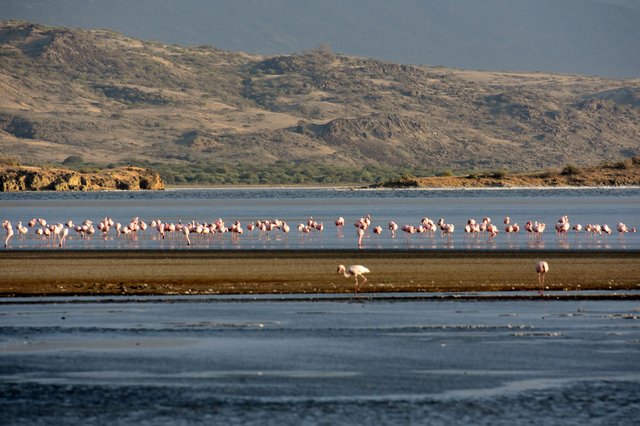Wonders of nature. Alkaline Lakes in East Africa

A chain of hissing soda lakes stretches along the East African rift system.
Colors of green peas, pink or dazzling white shallow alkaline lakes stretched along the East African rift system like a spilled necklace. Some shine under the equatorial sun because of crumbs of dried soda. Others, such as Lake Bogoria, bubble, and above them stands steam from hot springs.
Greenish or pink color, these lakes owe their flora and fauna: billions of microscopic algae and small invertebrates — crustaceans and molluscs, so numerous that the water boils up from air bubbles live in the water.

White lake becomes because of dry crystallized soda where the water evaporated. Basically, it is sodium carbonate, washed into the reservoirs of soda-rich soil and volcanic ash ejected from the volcanoes. The lakes Magadi and Natron, located in the gloomy southern extremity of the rift system and not having a runoff, are the deepest and hotest of all, the concentration of soda in them is greatest.
Lake Magadi lies in a remote semi-desert area, where the daytime temperature reaches 38°C, its water seems thick with soda. Lake Natron, which often looks spotty pink, is slightly milder in terms of soda concentration, but larger in size — 64 kilometers in length and 16 kilometers in width. Heat causes evaporation of more water from these lakes than enters them with rain, which falls just 400 millimeters per year.

A searing soda mash surrounds the shores of the lake; During the day, it can be heated to 65°C. In other soda lakes, such as Bogoria, Nakuru and Elmenteyta, the water is more fresh mainly because of the flow of rivers that carry part of the soda. But they also dry up from evaporation. In 1950, Elmenteyta and Nakuru almost completely disappeared, filling the air with a burning throat with dust.
Scientists believe that water from underground sources, penetrating through layers of soda of the East African rift system, will always carry soda to the lakes. In Magadi, soda is mined in industrial quantities since the beginning of the 20th century, its reserves are inexhaustible. Hot springs and geyser-emitting clouds are heated by volcanic rocks. Near the Bogoria lake boiling water splashes on the grass, posing a danger to those who come too close. In Natron and Magadi more or less fresh water comes only from hot springs, and in these lakes there live dwarf tilapia — fish adapted to life in hot water.

In the 1950s, British naturalist Leslie Brown, who was Kenya's chief agricultural officer, traveled to Lake Natron to find out whether flamingos seen from the air could reproduce there. To come closer and observe the birds, he had to walk more than 11 kilometers. At dawn, Brown left the camp and headed for the shore of the lake and further along the soda crust. At first the surface was firm, but soon she began to crumble under his feet. He began to drown in smelly liquor. It was becoming increasingly difficult to go, each step was given at a cost of enormous effort. To top it off, drinking water in his canvas bag became bitter with soda dust. Despite the fact that Brown was physically strong and had considerable hunting experience in Scotland, progress was so difficult that he had to turn back. Strong heat, dehydration and fatigue almost led to a tragic outcome. As soon as he reached the hard surface, he took off his shoes, which soda was poured into, and his legs in black bubbles immediately turned black, barely touching the air. It took six weeks for the treatment and several skin transplants before his legs healed a little.

Although these lakes are hostile to humans and many animals, about 3 million small and almost 50,000 large flamingos feel at home. Breeding birds usually fly to the most remote lakes, where shores with sod crust create an obstacle for jackals and other marauders.
Flamingos feed on algae and insect larvae. Tilting his head and turning his beak "upside down," they act as a ladle, grabbing water, and then strain the food out of the water and silt with a trowel contained in the beak.
Family life
Nest flamingos are huge colonies. Nests are built of silt with a depression at the top. In the laying one or two eggs. Nestlings hatch in a month. A week later, fluffy gray chicks gather in large groups, where they are looked for by parents to feed the red "milk" that they belch. While the chicks do not learn how to fly, which happens 11 weeks later, they often become prey to predators, such as the eagle-fisher.
And to think that it is one of the poorest places on the planet. :C
Congratulations! This post has been upvoted from the communal account, @minnowsupport, by Mamasetta from the Minnow Support Project. It's a witness project run by aggroed, ausbitbank, teamsteem, theprophet0, someguy123, neoxian, followbtcnews/crimsonclad, and netuoso. The goal is to help Steemit grow by supporting Minnows and creating a social network. Please find us in the Peace, Abundance, and Liberty Network (PALnet) Discord Channel. It's a completely public and open space to all members of the Steemit community who voluntarily choose to be there.
This post has received a 0.78 % upvote from @drotto thanks to: @banjo.
Resteemed your article. This article was resteemed because you are part of the New Steemians project. You can learn more about it here: https://steemit.com/introduceyourself/@gaman/new-steemians-project-launch